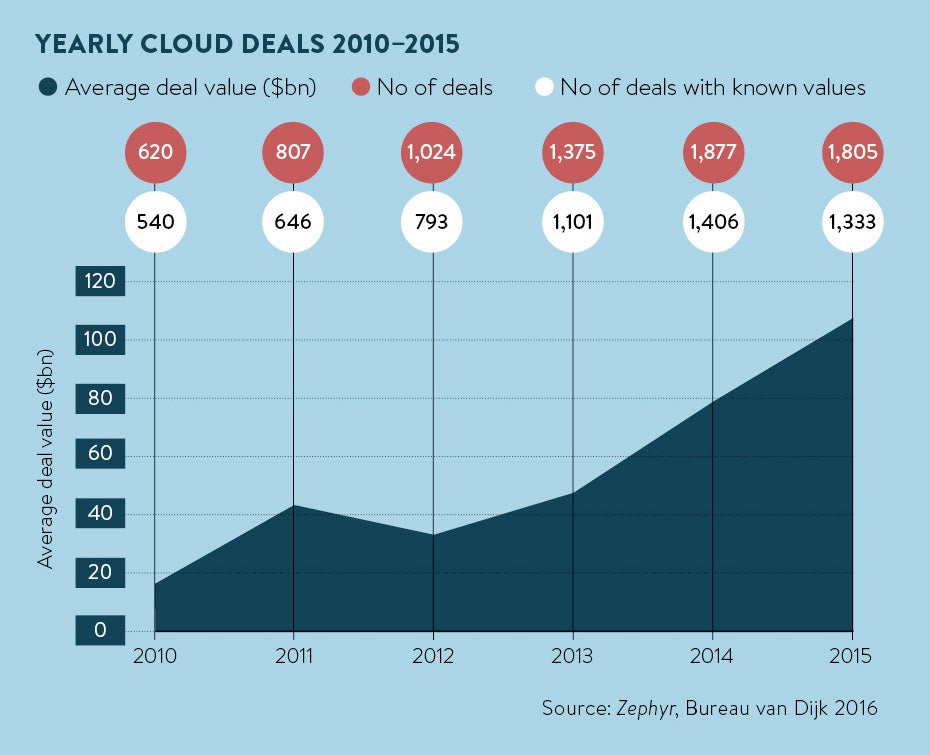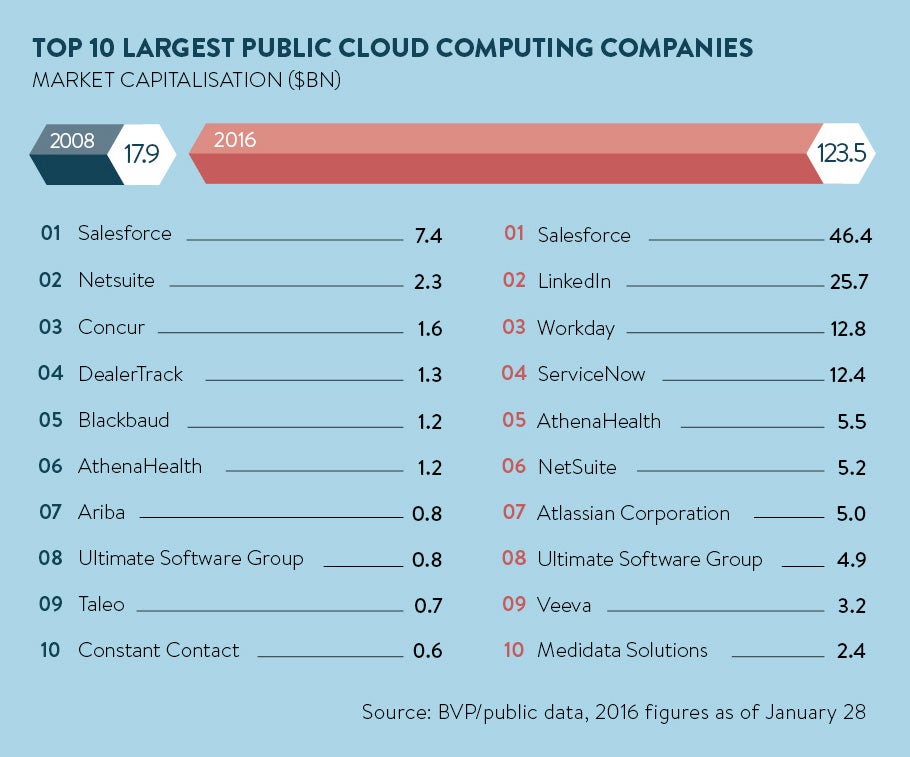Cloud may be a mainstream part of business rhetoric, but worries over data privacy and security have continued to temper curiosity and awareness, keeping investment and progress modest, particularly across the very sector which stands to benefit the most from its game-changing effects.
Indeed, free from the shackles of the legacy IT systems that constrain their larger counterparts, small and medium-sized enterprises (SMEs) are best placed to capitalise on the cost-saving, enhanced security and scalability the technology affords. But, for momentum to build, it seems a more ambitious vision is required that sees beyond simply cheaper infrastructure or the basics of e-mail services and databases, and thinks bigger and bolder.
Currently just under 14 per cent of the SME IT budget is spent on third-party managed IT services, largely cloud providers, according to Claranet.
“Mid-sized and large enterprises tend to be further down the road of cloud adoption than smaller companies with more complex estates driving greater levels of IT outsourcing,” says Neil Thomas, product director at managed services provider Claranet.
“But as data becomes more critical to business success, we will start to see progressive IT teams across all company sizes turn to cloud and managed service providers to support adoption and management, and for this to consume a far greater portion of IT budgets over the coming years.”
Click here for the full infographic
Turning to the cloud
It’s an approach already adopted by savvy operators, who are teaming up with software enterprise leaders to leverage the kind of state-of-the-art technology only possible through significant and sustained investment that traditionally would be prohibitive for their budgets.
Furthermore, by tapping into the knowledge pool of larger enterprise, they are more likely to avoid the pitfalls which continue to hinder smooth cloud adoption for many SMEs, from drawn-out migration processes – an average of 19 months, according to the Cloud Industry Forum Survey – to a need for additional investment in software and hardware after deployment.

One industry heavyweight providing the robust infrastructure along with the hand-holding expertise and counsel that comes from a 30-year heritage is TIBCO Software. Renowned for driving the digitalisation of Wall Street in the 1980s, when it comes to providing connections between applications and data, the Silicon Valley-based outfit has remained a trailblazer in the enterprise software market. TIBCO pioneers technology which extracts actionable and differentiating intelligence from a company’s data in real time in forensic detail.
Prompted by the demand for its core services to be available in the cloud, when European chief technology officer Maurizio Canton talks of the business’ “cloud journey”, it’s clearly a mission rather than just semantics.
The industry needs to overcome perceptions that the cloud is complex and something just for larger businesses by providing tailored offerings
“There’s no doubt that we are moving towards an era in which cloud will be the primary environment for our services,” he says. “We’re seeing particularly strong traction in both telco and retail sectors, where the technology is driving a more personalised customer experience.
“Importantly, though, the industry needs to overcome perceptions that the cloud is complex and something just for larger businesses by providing tailored offerings and not watered-down versions of solutions intended for the larger enterprise, which smaller operators don’t fully understand or use in its entirety.”
Data analytics
At the heart of the proposition is the pioneering Fast Data platform, which collates and presents data analysis in real time, the benefits of which are already being realised across a diverse range sectors from digital banking to oil and gas.
The cloud has been a great leveller, but we can go further by ensuring the offering is available across a range of options – public, private, hybrid or on-premise
Retailers such as clothing and outdoor equipment staple North Face use it to drill down into sales and marketing information to identify their customers’ purchasing habits and preferences. While motoring organisation, the AA, is bringing greater equity to how car premiums are assessed by using analytics to produce an accurate picture of a driver’s performance with sensors that track speed, braking and mileage, and collate the data into one definitive bundle. Thanks to a cloud makeover, this technology is to become even more accessible and available within an accelerated framework.
With all indications pointing to continued but cautious adoption – pockets of cloud in tandem with on-premises solutions – Mr Canton is a strong advocate of providers offering a more integrated and flexible offering that can evolve with business needs.

“Startups have the ideas and the passion, but not always the money” he says. “The cloud has been a great leveller, but we can go further by ensuring the offering is available across a range of options – public, private, hybrid or on-premise. True innovation is often about failing quickly, recovering and trying something else, and not confining the customer to a particular path, an approach that will be vital to their investment.”
In the meantime, customers are benefiting from TIBCO’s sustained investment, bolstered by the recent acquisition of API (application programming interface) manager leader Mashery and expansion of its SaaS-based (software as a service) integration capabilities. The result has evolved the cloud proposition further to enable the development of even more compelling, multi-purpose applications, which can elevate the customer offering, in some cases, to industry-leading heights.
Smart homes and the cloud
A case in point is the partnership with smart home technology provider digitalSTROM, a young brand which relies on the TIBCO Fast Data platform to connect the home and its various appliances to the cloud so they can communicate with each other.
A patented terminal block, akin to a LEGO brick, houses an integrated chip which enables all electrical devices, from smoke detectors to doorbells, to connect into one flexible, smart network using the home’s existing electrical wires. Running in the background, the Fast Data platform captures insight and co-ordinates all processes connected with the service, reliably and quickly, a fusion of innovation that has generated a 100 per cent growth and underpinned chief executive Martin Vesper’s vision to become the smart home solution across Europe.
“Our goal was to provide an infrastructure where cloud-based services, such as weather and security, can be used easily and reliably to make people’s homes smart and reactive to events, but without a large cost,” he says. “To do this we needed cloud-computing services and very high performance because latency is a big issue in the home and an open, yet very secure and reliable platform.”
And the old adage around cloud creating a level playing field more than bears out in the wake of digitalSTROM’s recent triumph at the Internet of Things Awards where it defeated industry titans Orange and Nest in the smart home category.
[embed_related]
Analysing data
Of course, smart home solutions are not the only machine-to-machine (M2M) technology thriving in a more consumer-driven and 4G-enabled environment, which is spiking demand for increasingly sophisticated applications to manage and monitor assets from pet-tracking to fuel consumption to optimise efficiencies.
It’s a process that relies on the seamless communication of data across the company’s network infrastructure, with information captured from the device and transmitted across a mobile network to be put into action. And as more complex, feature-rich devices bump up the bandwidth, watertight cloud connectivity becomes prerequisite.

Yet managing extreme data volumes and velocity without compromising connectivity demands a level of infrastructure often well beyond the budgets of the smaller players. Tapping into the scope and resources of a M2M network managed service provider, therefore, can be an attractive proposition for those wanting to leverage the reliability, resilience and real-time usage monitoring benefits that come with a seven-figure network investment.
In occupying the space between device creator and network operator, Wireless Logic is one such M2M provider making this infrastructure a more accessible reality for a broader demographic, privately managing internet of things (IoT) and M2M infrastructure across the European networks for a range of vertical markets.
Acquired by TV’s Dragons’ Den entrepreneur Peter Jones and sold back to the co-founders in 2011 for £38 million, the Beaconsfield-based outfit understands the nuances of network choice and tailors solutions accordingly to avoid the bugbears of congestion and latency.
At the heart of the proposition is the cloud-based network Net Pro, the fruition of a £3-million investment which delivers large-scale private networking for minimal cost as an affordable software platform. By acting as an overlay network for global mobile operators from Vodafone to O2, all of which are connected through one central management application, customers have the access and choice that ensures visibility, control and coverage across the network.
“It’s the kind of high-end solution that would not be so readily available as an off-the-shelf solution on a smaller scale from a mobile network operator and negates investment in complex IT architecture, connectivity or in-house specialist engineers,” says co-founder Philip Cole. “Just one username and password is needed to access a portal of global IoT connectivity in 80 countries.”
The cloud is already a great leveller, but for smaller players adopting a collaborative approach can take things up a gear and ensure even more bang for your buck.
CASE STUDY: YAKULT’S HEALTHY IN THE CLOUD
 Cloud-based data analytics has enabled leading probiotic drinks business Yakult to keep a steer on competitors and enjoy a 20 per cent rise in sales in the Netherlands, all on the back of a modest £2,000 annual investment.
Cloud-based data analytics has enabled leading probiotic drinks business Yakult to keep a steer on competitors and enjoy a 20 per cent rise in sales in the Netherlands, all on the back of a modest £2,000 annual investment.
TIBCO’s business intelligence tool Spotfire turned detective for the fermented milk drink giant to shed light on why the emergence of more competitors in the market had led to a hike in Yakult’s Dutch sales.
“You would have expected a loss of market share, but in fact it seemed like there was a synergy between the competitors,” says Yakult market analyst Egbert Jan Vierkant. “After several years of steady sales, we experienced an extraordinary increase and we wanted to know why, but analysis using spreadsheets and fragmented multiple data sources was just time consuming, ineffective and not revealing any answers.”
In need of a solution that could integrate all strands of data from the sales and marketing mix, attention turned to Spotfire’s ability to draw core intelligence into one place and drill down deep into the detail to provide a full overview of their market.
From region and gender-specific purchasing behaviour to weather data and Google searches, a whole raft of diverse insight has been brought to life through visually compelling graphics to provide a clear snapshot of the sales drivers that would otherwise be buried in spreadsheets.
Knowledge gleaned has informed the marketing budget, fuelled further growth and can be shared with retailers stocking the product so they can tailor orders and shelf display to their customer demographic.
By finding the solution in the cloud, Yakult has been able to exploit faster and more flexible access, easy expansion and sharing of the analysis that has delivered tangible value to the bottom line with minimal investment and seamless installation.
Turning to the cloud

Data analytics






